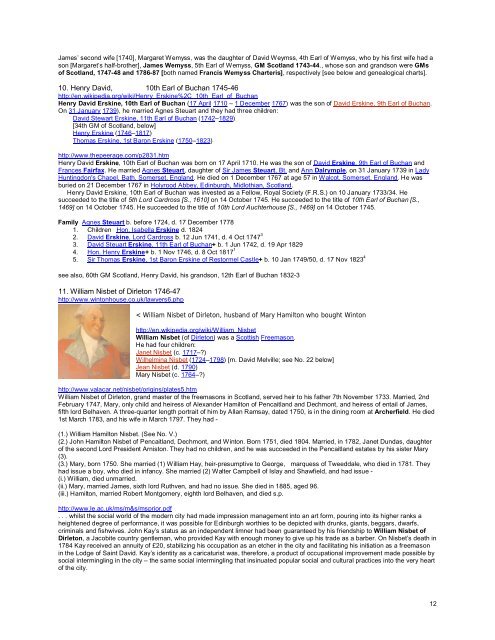Grand Masters of Scotland - Onondaga and Oswego Masonic ...
Grand Masters of Scotland - Onondaga and Oswego Masonic ...
Grand Masters of Scotland - Onondaga and Oswego Masonic ...
You also want an ePaper? Increase the reach of your titles
YUMPU automatically turns print PDFs into web optimized ePapers that Google loves.
James’ second wife [1740], Margaret Wemyss, was the daughter <strong>of</strong> David Weymss, 4th Earl <strong>of</strong> Wemyss, who by his first wife had a<br />
son [Margaret’s half-brother], James Wemyss, 5th Earl <strong>of</strong> Wemyss, GM <strong>Scotl<strong>and</strong></strong> 1743-44., whose son <strong>and</strong> gr<strong>and</strong>son were GMs<br />
<strong>of</strong> <strong>Scotl<strong>and</strong></strong>, 1747-48 <strong>and</strong> 1786-87 [both named Francis Wemyss Charteris], respectively [see below <strong>and</strong> genealogical charts].<br />
10. Henry David, 10th Earl <strong>of</strong> Buchan 1745-46<br />
http://en.wikipedia.org/wiki/Henry_Erskine%2C_10th_Earl_<strong>of</strong>_Buchan<br />
Henry David Erskine, 10th Earl <strong>of</strong> Buchan (17 April 1710 – 1 December 1767) was the son <strong>of</strong> David Erskine, 9th Earl <strong>of</strong> Buchan.<br />
On 31 January 1739), he married Agnes Steuart <strong>and</strong> they had three children:<br />
David Stewart Erskine, 11th Earl <strong>of</strong> Buchan (1742–1829)<br />
[34th GM <strong>of</strong> <strong>Scotl<strong>and</strong></strong>, below]<br />
Henry Erskine (1746–1817)<br />
Thomas Erskine, 1st Baron Erskine (1750–1823)<br />
http://www.thepeerage.com/p2831.htm<br />
Henry David Erskine, 10th Earl <strong>of</strong> Buchan was born on 17 April 1710. He was the son <strong>of</strong> David Erskine, 9th Earl <strong>of</strong> Buchan <strong>and</strong><br />
Frances Fairfax. He married Agnes Steuart, daughter <strong>of</strong> Sir James Steuart, Bt. <strong>and</strong> Ann Dalrymple, on 31 January 1739 in Lady<br />
Huntingdon's Chapel, Bath, Somerset, Engl<strong>and</strong>. He died on 1 December 1767 at age 57 in Walcot, Somerset, Engl<strong>and</strong>. He was<br />
buried on 21 December 1767 in Holyrood Abbey, Edinburgh, Midlothian, <strong>Scotl<strong>and</strong></strong>.<br />
Henry David Erskine, 10th Earl <strong>of</strong> Buchan was invested as a Fellow, Royal Society (F.R.S.) on 10 January 1733/34. He<br />
succeeded to the title <strong>of</strong> 5th Lord Cardross [S., 1610] on 14 October 1745. He succeeded to the title <strong>of</strong> 10th Earl <strong>of</strong> Buchan [S.,<br />
1469] on 14 October 1745. He succeeded to the title <strong>of</strong> 10th Lord Auchterhouse [S., 1469] on 14 October 1745.<br />
Family Agnes Steuart b. before 1724, d. 17 December 1778<br />
1. Children Hon. Isabella Erskine d. 1824<br />
2. David Erskine, Lord Cardross b. 12 Jun 1741, d. 4 Oct 1747 3<br />
3. David Steuart Erskine, 11th Earl <strong>of</strong> Buchan+ b. 1 Jun 1742, d. 19 Apr 1829<br />
4. Hon. Henry Erskine+ b. 1 Nov 1746, d. 8 Oct 1817 1<br />
5. Sir Thomas Erskine, 1st Baron Erskine <strong>of</strong> Restormel Castle+ b. 10 Jan 1749/50, d. 17 Nov 1823 4<br />
see also, 60th GM <strong>Scotl<strong>and</strong></strong>, Henry David, his gr<strong>and</strong>son, 12th Earl <strong>of</strong> Buchan 1832-3<br />
11. William Nisbet <strong>of</strong> Dirleton 1746-47<br />
http://www.wintonhouse.co.uk/lawyers6.php<br />
< William Nisbet <strong>of</strong> Dirleton, husb<strong>and</strong> <strong>of</strong> Mary Hamilton who bought Winton<br />
http://en.wikipedia.org/wiki/William_Nisbet<br />
William Nisbet (<strong>of</strong> Dirleton) was a Scottish Freemason.<br />
He had four children:<br />
Janet Nisbet (c. 1717–?)<br />
Wilhelmina Nisbet (1724–1798) [m. David Melville; see No. 22 below]<br />
Jean Nisbet (d. 1790)<br />
Mary Nisbet (c. 1764–?)<br />
http://www.valacar.net/nisbet/origins/plates5.htm<br />
William Nisbet <strong>of</strong> Dirleton, gr<strong>and</strong> master <strong>of</strong> the freemasons in <strong>Scotl<strong>and</strong></strong>, served heir to his father 7th November 1733. Married, 2nd<br />
February 1747, Mary, only child <strong>and</strong> heiress <strong>of</strong> Alex<strong>and</strong>er Hamilton <strong>of</strong> Pencaitl<strong>and</strong> <strong>and</strong> Dechmont, <strong>and</strong> heiress <strong>of</strong> entail <strong>of</strong> James,<br />
fifth lord Belhaven. A three-quarter length portrait <strong>of</strong> him by Allan Ramsay, dated 1750, is in the dining room at Archerfield. He died<br />
1st March 1783, <strong>and</strong> his wife in March 1797. They had -<br />
(1.) William Hamilton Nisbet. (See No. V.)<br />
(2.) John Hamilton Nisbet <strong>of</strong> Pencaitl<strong>and</strong>, Dechmont, <strong>and</strong> Winton. Born 1751, died 1804. Married, in 1782, Janet Dundas, daughter<br />
<strong>of</strong> the second Lord President Arniston. They had no children, <strong>and</strong> he was succeeded in the Pencaitl<strong>and</strong> estates by his sister Mary<br />
(3).<br />
(3.) Mary, born 1750. She married (1) William Hay, heir-presumptive to George, marquess <strong>of</strong> Tweeddale, who died in 1781. They<br />
had issue a boy, who died in infancy. She married (2) Walter Campbell <strong>of</strong> Islay <strong>and</strong> Shawfield, <strong>and</strong> had issue -<br />
(i.) William, died unmarried.<br />
(ii.) Mary, married James, sixth lord Ruthven, <strong>and</strong> had no issue. She died in 1885, aged 96.<br />
(iii.) Hamilton, married Robert Montgomery, eighth lord Belhaven, <strong>and</strong> died s.p.<br />
http://www.le.ac.uk/ms/m&s/msprior.pdf<br />
. . . whilst the social world <strong>of</strong> the modern city had made impression management into an art form, pouring into its higher ranks a<br />
heightened degree <strong>of</strong> performance, it was possible for Edinburgh worthies to be depicted with drunks, giants, beggars, dwarfs,<br />
criminals <strong>and</strong> fishwives. John Kay’s status as an independent limner had been guaranteed by his friendship to William Nisbet <strong>of</strong><br />
Dirleton, a Jacobite country gentleman, who provided Kay with enough money to give up his trade as a barber. On Nisbet’s death in<br />
1784 Kay received an annuity <strong>of</strong> £20, stabilizing his occupation as an etcher in the city <strong>and</strong> facilitating his initiation as a freemason<br />
in the Lodge <strong>of</strong> Saint David. Kay’s identity as a caricaturist was, therefore, a product <strong>of</strong> occupational improvement made possible by<br />
social intermingling in the city – the same social intermingling that insinuated popular social <strong>and</strong> cultural practices into the very heart<br />
<strong>of</strong> the city.<br />
12







![Richard [Nicholls] Harison / Harrison - Onondaga and Oswego ...](https://img.yumpu.com/24950065/1/190x245/richard-nicholls-harison-harrison-onondaga-and-oswego-.jpg?quality=85)
![Richard [Nicholls] Harison / Harrison - Onondaga and Oswego ...](https://img.yumpu.com/24950063/1/190x245/richard-nicholls-harison-harrison-onondaga-and-oswego-.jpg?quality=85)








